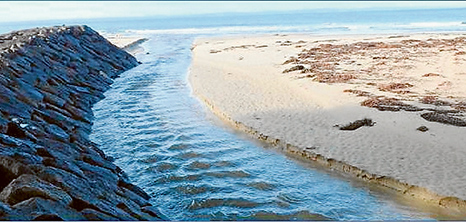ROTTEN egg gas – or sulphur dioxide – is described as being the by-product of an “environmental tragedy” occurring along Western Port beaches, especially at Balnarring and Somers’.
Merricks Creek and Estuary Working Group members have discussed solutions to the stink and agreed to the estuary being temporarily closed.
The group was formed to provide community input into an independent study to investigate whether there is a practicable option to controlling the pong.
Melbourne Water’s Georgina Downey has told the group that the objective is to find a permanent solution to the problem.
“While the construction of a sand groyne will help in the short-term, the group is still developing a long-term solution that will allow the estuary to open and close naturally,” she stated in a newsletter.
“[Consultants] Alluvium was appointed by Melbourne Water to undertake an independent study into the reasons for the odour and to come up with possible solutions.
“The main finding was that the persistent odour experienced at the estuary is due to hydrogen sulphide or ‘rotten egg’ gas caused by the breakdown of the large amount of seagrass which has accumulated in the estuary.
“They found that because the estuary is permanently open, seagrass on the beach is carried up the estuary and deposited there.
“The working group agreed that the estuary be temporarily closed to mimic the natural closing of the estuary and prevent any more seagrass entering the estuary prior to the completion of a longer term solution by the end of autumn next year.”
A sand groyne will be used to close the estuary, but the estuary will be reopened “if necessary”.
Triggers for reopening the estuary include higher than normal levels of “rotten egg” gas, poor water quality, if high water levels threaten local flooding, and if the smell of decomposing seagrass “becomes unbearable”.
“The shire will liaise with the Merricks Estuary Watch group and the community to monitor the site. They will gauge how the estuary responds to the mouth closure, and if there is any deterioration in conditions, and will look to reopen the estuary if necessary,” Ms Downey said.
Balnarring Ratepayers’ Association is concerned that gas concentrations in Merricks Creek are increasing because “over 200 percent of its catchment is being taken by the uncontrolled growth of large dams by wineries”, a member said.
“This lack of catchment flow has resulted in huge amounts of seaweed being pushed up Merricks Creek.”




